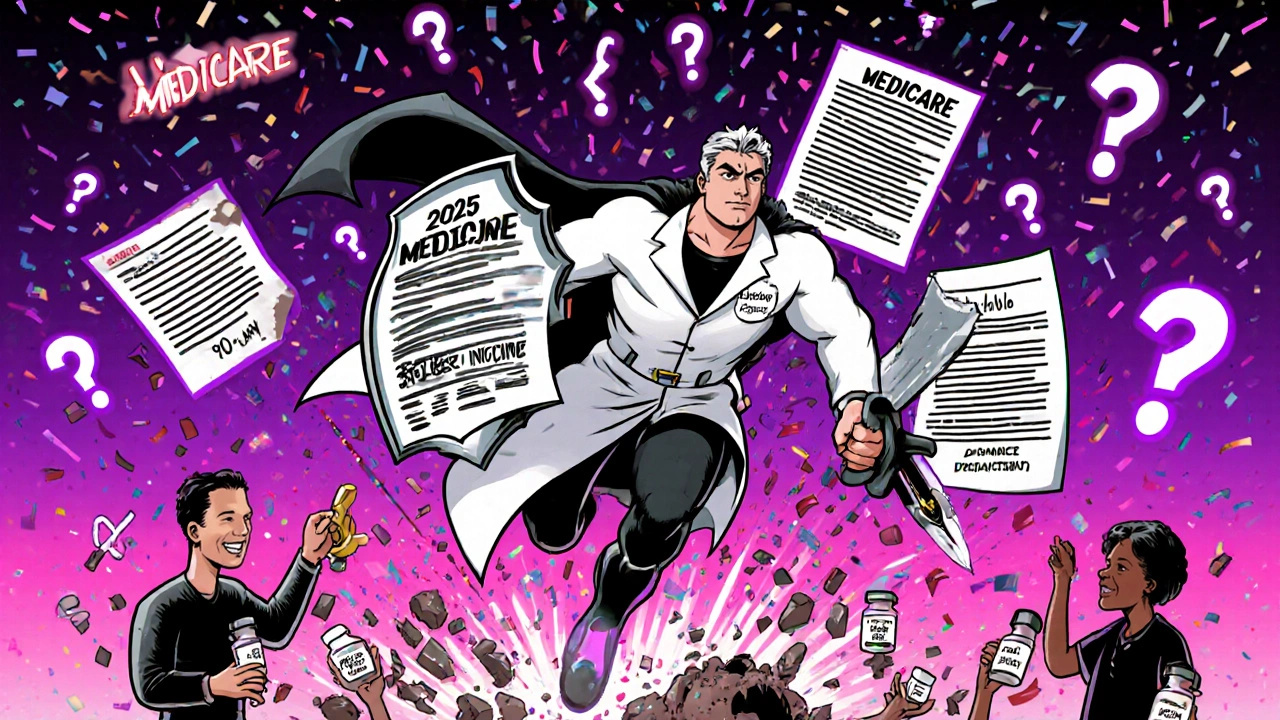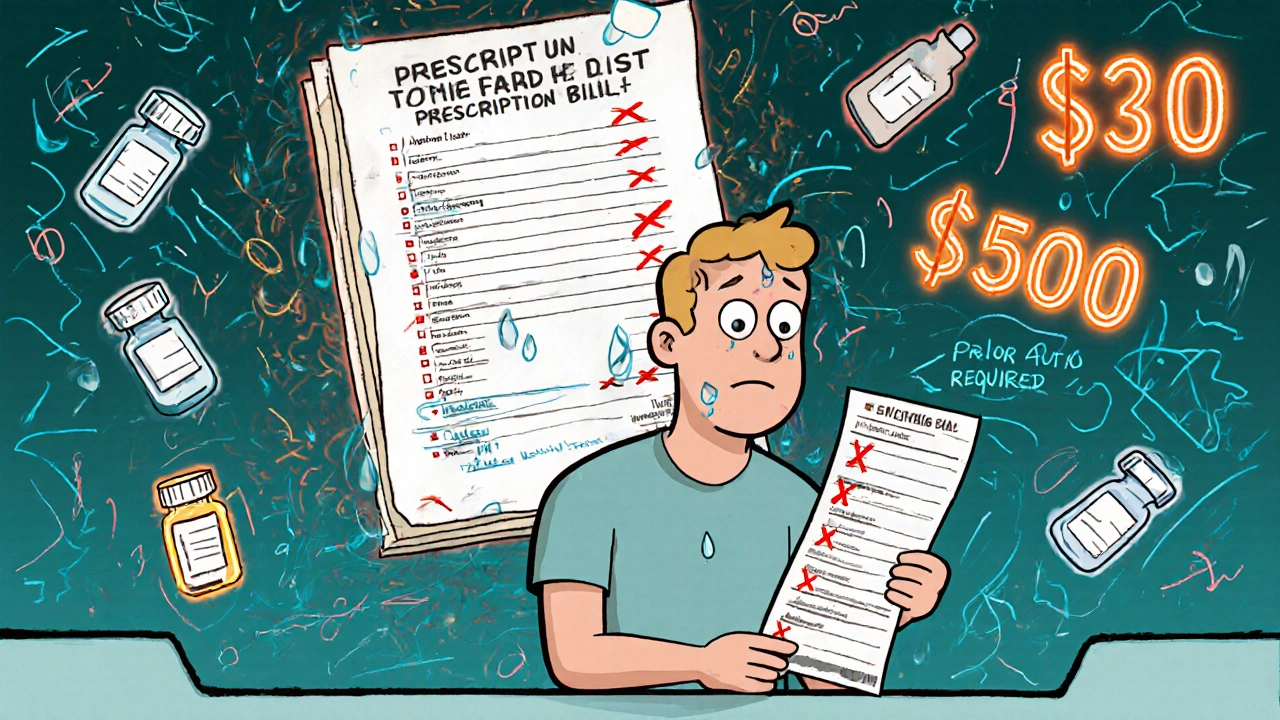Almost two-thirds of Americans take at least one prescription drug every year. That means for most people, health insurance isn’t just about doctor visits or hospital stays-it’s about whether your insulin, blood pressure pill, or asthma inhaler is covered, and how much you’ll actually pay for it. Yet, too many people enroll in a plan without checking if their medications are included. By the time they walk into the pharmacy, they’re shocked by a $500 bill for a drug they thought was covered. You don’t have to be one of them.
Is my medication on the formulary?
Every insurance plan has a list of drugs it covers called a formulary. This isn’t a secret document-it’s published online by your insurer. But here’s the catch: just because a drug is FDA-approved doesn’t mean your plan covers it. Some plans exclude certain brand-name drugs even when generics exist. Others only cover specific versions of a drug (like extended-release over immediate-release). If you take a medication regularly, look up its exact name and dosage on the formulary. Don’t assume. Don’t guess. Type it in yourself. If it’s not listed, call customer service and ask: “Is there a therapeutic alternative that’s covered?” Sometimes, a similar drug with the same effect is on Tier 1 instead of Tier 4.What tier is my drug on-and what does that cost?
Formularies are divided into tiers, and each tier has a different price. Tier 1 is usually generic drugs with a $10 copay. Tier 2 is preferred brand-name drugs, often around $40. Tier 3 is non-preferred brands, which can jump to $100 or more. Tier 4? That’s specialty drugs-like those for rheumatoid arthritis, multiple sclerosis, or cancer. These often require coinsurance (you pay a percentage of the total cost), not a flat copay. One person on a Silver plan thought their $1,200 monthly drug was covered, only to find out they owed 30% of the cost-$360 per month, or over $4,300 a year. That’s not a surprise; it’s a failure to check the tier. Always ask: “What tier is my drug on, and what’s the exact copay or coinsurance?”Do I have to meet a deductible first?
Not all plans start covering prescriptions right away. Many, especially Bronze and some Silver Marketplace plans, require you to hit a deductible before any drug coverage kicks in. That means if your deductible is $6,000 and you need a $300 monthly medication, you’re paying full price for 20 months. That’s $6,000 out of pocket before insurance helps. Ask: “Does my plan have a prescription drug deductible, and if so, how much is it?” If you take multiple meds, a plan with no drug deductible-even if the premium is higher-could save you thousands.Are there prior authorization requirements?
Some drugs require your doctor to get approval from your insurance before they’ll pay for them. This is called prior authorization. It’s common for expensive brand-name drugs, newer treatments, or drugs with cheaper alternatives. If your doctor prescribes a drug that needs prior auth, and your plan denies it, you might have to wait weeks or switch meds. Ask: “Does my medication require prior authorization?” If yes, ask your doctor to submit it early. Don’t wait until you’re at the pharmacy counter.
Is step therapy required?
Step therapy means your plan forces you to try a cheaper drug first before covering the one your doctor prescribed. For example, you might need to try two generic blood pressure pills before your insurer will cover the brand-name version. This can delay treatment, cause side effects, or even make your condition worse. Ask: “Does my plan require step therapy for my medication?” If you’ve tried the cheaper options before and they didn’t work, ask your doctor to include a letter of medical necessity when submitting the prior auth.Which pharmacies can I use?
Your plan might cover your drug-but only if you fill it at certain pharmacies. Many plans use narrow networks: CVS, Walgreens, or a local chain. If you go to a pharmacy outside the network, you might pay 37% more-or even the full price. Ask: “Which pharmacies are in-network?” Then check if your usual pharmacy is on the list. If not, ask if there’s a mail-order option. Some plans offer 90-day supplies through mail-order pharmacies at lower costs.What’s the out-of-pocket maximum for prescriptions?
This is the most you’ll pay in a year for covered drugs. Once you hit it, your plan pays 100% for the rest of the year. But here’s the trick: some plans have separate out-of-pocket maximums for medical and drug costs. Others combine them. If your plan has a $9,450 out-of-pocket maximum for medical care but no separate cap for drugs, you could pay thousands more on prescriptions alone. Ask: “Is there a separate out-of-pocket maximum for prescription drugs, and what is it?” For people on multiple medications, a lower drug cap can make a huge difference.
Are there any coverage limits or quantity restrictions?
Some plans limit how much of a drug you can get in a month. For example, they might cover only 30 pills when your doctor prescribed 60. Or they might not cover refills until 10 days before your current supply runs out. This can be dangerous for chronic conditions. Ask: “Is there a monthly or annual limit on the quantity of my medication?” If you need a 90-day supply for convenience, ask if it’s covered. Many plans offer discounts for 90-day fills through mail-order.What changes are coming in 2025?
Starting in 2025, Medicare Part D will have a $2,000 annual out-of-pocket cap on drug costs. That’s a big deal. It also eliminates the “donut hole” completely. Insulin will be capped at $35 per month. These changes don’t apply to private plans, but they’re reshaping the entire market. Even if you’re not on Medicare, ask: “Will my plan change its structure in 2025 to match these new rules?” Some private insurers are already adjusting. Knowing this helps you plan ahead.How do I check coverage before I enroll?
Don’t wait until after you sign up. Use the tools available. On HealthCare.gov, you can enter up to 15 medications and three pharmacies to compare plans side by side. For Medicare, use the Medicare Plan Finder and enter your drugs by NDC code (that’s the 11-digit number on the bottle). Spend 20 minutes. That’s all it takes. People who do this save an average of $1,147 a year. If you’re switching plans during Open Enrollment (November 1 to January 15 for Marketplace, October 15 to December 7 for Medicare), use this time wisely. Don’t just pick the cheapest premium. Pick the plan that covers your drugs at the lowest total cost.Prescription drug coverage isn’t a bonus-it’s a necessity. For many, it’s the difference between taking your medicine and skipping doses. Don’t let confusing terms, hidden deductibles, or network surprises cost you your health. Ask the questions. Check the formulary. Compare the numbers. The right plan can save you thousands-and keep you healthy.
What if my medication isn’t on the formulary?
If your medication isn’t covered, ask your insurer if there’s a covered alternative with the same active ingredient or therapeutic effect. You can also ask your doctor to submit a prior authorization request with a letter explaining why the covered alternatives won’t work for you. Some plans will approve coverage if you demonstrate medical necessity. You can also file an appeal if your request is denied.
Can I switch plans if my drug coverage changes mid-year?
Generally, no-you can only change plans during Open Enrollment unless you qualify for a Special Enrollment Period. Qualifying events include losing other coverage, moving out of your plan’s service area, or getting Medicaid. If your drug is removed from the formulary mid-year, your plan must give you at least a 60-day transition period to finish your current prescription or switch to a covered alternative. You can’t switch plans just because you’re unhappy with coverage, but you can prepare for next year’s Open Enrollment.
Do Medicare Advantage plans cover prescriptions better than standalone Part D?
It depends. Medicare Advantage plans often have lower premiums and include medical and drug coverage in one plan, but they usually have tighter pharmacy networks. About 68% of Advantage plans use tiered pharmacy networks, compared to 42% of standalone Part D plans. Standalone Part D plans may offer more flexibility in choosing pharmacies and have simpler formularies. If you’re on multiple medications or use specialty drugs, compare both options using the Medicare Plan Finder. Look at total out-of-pocket costs-not just monthly premiums.
Why do two plans with the same premium have different drug costs?
Because formularies and cost-sharing structures vary widely. One plan might cover your drug on Tier 1 with a $10 copay, while another puts it on Tier 3 with a $100 copay-even if both have the same monthly premium. One might have no drug deductible; the other might require you to pay $6,000 before coverage starts. Always compare plans using your actual medications, not just the premium. The cheapest plan isn’t always the cheapest when you need your prescriptions.
How do I know if a drug is considered specialty?
Specialty drugs are typically high-cost medications used to treat complex, chronic conditions like cancer, rheumatoid arthritis, or multiple sclerosis. They often require special handling (like refrigeration), administration by a healthcare provider, or close monitoring. Most plans classify them as Tier 4. Check your plan’s formulary-specialty drugs are usually labeled as such. If you’re unsure, call your insurer and ask: “Is this drug classified as specialty?”


Comments
Tiffany Fox
November 28, 2025 AT 03:17Just checked my formulary last week-turns out my thyroid med’s on Tier 3 and I had no clue. Paid $120 last refill. Now I’m switching plans during open enrollment. Don’t be like me.
ka modesto
November 29, 2025 AT 21:21Bro, I literally printed out my entire formulary and color-coded it. Green = covered, red = ‘hope you like paying full price.’ Took me 3 hours but saved me $2k last year. You’re welcome.
Tressie Mitchell
November 30, 2025 AT 21:24If you’re still confused about tiers and prior auth, you shouldn’t be managing your own healthcare. This is basic due diligence. The fact that people need a 10-question checklist to not go bankrupt on insulin is a national disgrace.
Keith Avery
December 1, 2025 AT 17:24Everyone’s acting like this is revolutionary. Newsflash: insurance companies have been hiding this stuff since the 90s. The real question is why we’re still letting them get away with it. Also, ‘therapeutic alternative’ is corporate speak for ‘take this cheaper junk and suffer.’
Cindy Burgess
December 1, 2025 AT 21:49While I appreciate the comprehensive nature of the enumerated inquiries delineated herein, one must question the epistemological validity of relying upon formularies that are subject to unilateral revision by third-party administrators without substantive recourse. The structural inequities inherent in the current pharmaceutical reimbursement paradigm remain unaddressed by mere procedural vigilance.
Chelsey Gonzales
December 3, 2025 AT 10:59omg i just realized my mail order pharmacy is 20 mins away and i’ve been driving 45 mins to walgreens bc i forgot to check… smh. gonna fix it this weekend lol
Luke Webster
December 4, 2025 AT 15:50My mom’s on 7 meds. We spent a weekend comparing 4 plans using the Medicare Plan Finder. One plan saved her $1,800 a year. It’s not glamorous, but it’s life-changing. Don’t skip the 20 minutes. Seriously. Your future self will cry happy tears.
Holly Lowe
December 4, 2025 AT 22:27My doctor tried to give me the generic for my anxiety med and I was like ‘babe, that stuff turns me into a zombie with a 2-hour attention span.’ We fought the prior auth, won, and now I’m functioning like a human again. Don’t let them gaslight you into taking junk. Your brain matters.